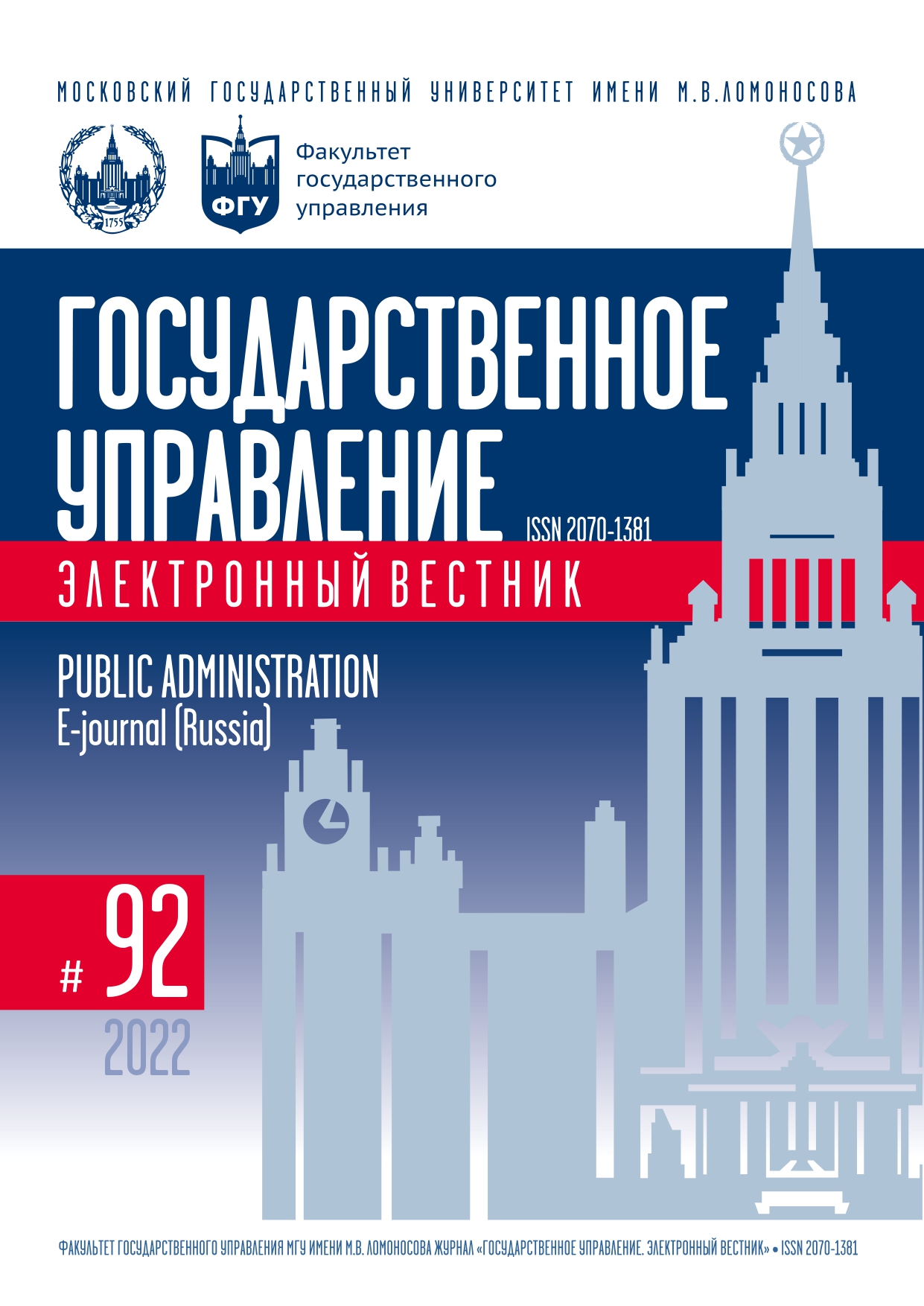Stimulating Investment Activity as а Key Element of Managing Modern Russian Economy Development
Keywords:
Investment activity, technological order, investment climate, strategic economic development, strategic programs, development of regional economyAbstract
The topic of stimulating investment activity as a key element of economic development management is of particular interest for solving the modernization tasks facing the Russian state and advanced development of the economy on the basis of a new technological order through strategic planning. Stimulating investment activity is especially relevant at the present time, when Russia is simultaneously facing the remaining consequences of the pandemic and unprecedented sanctions from the United States and its satellites. The purpose of the study is to develop a system of necessary measures to stimulate investment activity in the modern Russian economy. The subject of the study is the stimulation of investment activity. The theoretical basis of the research contains the theory of changing technological and world economic patterns; the theory of scientific and technological progress, the theoretical concept of Eurasian integration and the greater Eurasian partnership; the theoretical ideas of D. Keynes and D. Clark about the relationship between economic growth and investment; Tobin’s monetary theory; econometric models of economic growth; the theory of evolutionary economics; empirical studies of Russian and foreign scientists on the relationship of monetization, accumulation rate and credit intensity; international comparisons of the economic development of Russia, China, the USA and other countries. As a result, the study allowed describing ways to improve the investment climate at the regional and sectoral levels, in the context of its main components, in the context of the complexity of the Russian economy. The obtained results can be used to form strategic programs for developing the national economy, taking into account global technological trends and determining the directions of using investments to achieve the set goals and overcome existing challenges.
References
Блинов С. Денежная политика количественного смягчения при высоких ставках центрального банка // MPRA Paper. 2014. URL: https://www.econbiz.de/Record/
Горидько Н.П., Нижегородцев Р.М. Феномен «роста на ожиданиях»: регрессионный анализ и релятивистская концепция времени в экономике // Вестник экономической интеграции. 2011. № 12. С. 11–27.
Кейнс Дж.М. Общая теория занятости, процента и денег. М.: Прогресс, 1978.
Механизмы стимулирования сверхбыстрого роста: мировая практика / под ред. Я.М. Миркина. М.: Магистр, 2018.
Никитина С.А. Эволюция денежно-кредитной политики Японии и программа «Абэномики» // Вестник Института экономики Российской академии наук. 2015. № 6. С. 151–165.
Солодкая Т.И., Тали М.М., Индустриев М.А. Анализ влияния банковского сектора на экономический рост Российской Федерации // Известия Саратовского университета. Новая серия. Серия: Экономика. Управление. Право. 2018 Т. 18. № 2. С. 148–154. DOI: 10.18500/1994-2540-2018-18-2-148-154
Сухарев О.С. Инвестиционная функция экономического роста России // Финансы: теория и практика. 2021. Т. 25. № 1. С. 35–50. DOI: 10.26794/2587-5671-2021-25-1-35-50
Тепляков А.Ю. Смена технологических укладов и эволюция промышленной политики // XXIII Кондратьевские чтения: Тупики глобальной экономики, поиск новой научной парадигмы: Сборник статей участников конференции. 2015. С. 275–280.
Тимохина Л.А. Особенности инфляции в России и меры борьбы с ней // Инновационное развитие экономики: инструменты и технологии: Материалы XI международной научно-практической конференции студентов и молодых ученых. Волгоград: Изд-во Волгоградского института управления — филиала РАНХиГС, 2018. С. 108–110.
Толкачев С.А. Сетевая промышленная политика в эпоху новой индустриальной революции // Журнал НЭА. 2018. № 3 (39). C. 155–161. DOI: 10.31737/2221-2264-2018-39-3-9
Широв А.А., Янтовский А.А. Оценка мультипликативных эффектов в экономике. Возможности и ограничения // Всероссийский экономический журнал ЭКО. 2011. № 2 (440) С. 40–58.
Abbritti M., Aguilera-Bravo A., Trani T. Long-Term Business Relationships, Bargaining and Monetary Policy // Economic Modelling. 2021. Vol. 101. DOI: 10.1016/j.econmod.2021.105551
Azad N.F., Serletis A., Xu L. Covid-19 and Monetary-Fiscal Policy Interactions in Canada // The Quarterly Review of Economics and Finance. 2021. Vol. 81. P. 376–384. DOI: 10.1016/j.qref.2021.06.009
Azariadis C., Bullard J., Singh A., Suda J. Incomplete Credit Markets and Monetary Policy // Journal of Economic Dynamics and Control. 2019. Vol. 103. P. 83–101. DOI: 10.1016/j.jedc.2019.03.005
Bianco T. Monetary Policy and Credit Flows // Journal of Macroeconomics. 2021. Vol. 70. DOI: 10.1016/j.jmacro.2021.103362
Boucekkine R., Laksaci M., Touati-Tliba M. Long-Run Stability of Money Demand and Monetary Policy: The Case of Algeria // The Journal of Economic Asymmetries. 2021. Vol. 24. DOI: 10.1016/j.jeca.2021.e00217
Breitenlechner M., Scharler J. Monetary Policy Announcements and Bank Lending: Do Banks’ Refinancing Markets Matter? // Economic Modelling. 2021. Vol. 102. DOI: 10.1016/j.econmod.2021.105559
Cai Y. Expansionary Monetary Policy and Credit Allocation: Evidence from China // China Economic Review. 2021. Vol. 66. DOI: 10.1016/j.chieco.2021.101595
Chiu J., Molico M. Short-Run Dynamics in a Search-Theoretic Model of Monetary Exchange // Review of Economic Dynamics. 2021. Vol. 42. P. 133–155. DOI: 10.1016/j.red.2020.10.009
Clark J.B. Distribution of Wealth. London; New York: Macmillan, 1899.
Cobham D., Song M. How Do Countries Choose Their Monetary Policy Frameworks? // Journal of Policy Modeling. 2020. Vol. 42. Is. 6. P. 1187–1207. DOI: 10.1016/j.jpolmod.2020.04.008
Cobham D., Song M. Transitions Between Monetary Policy Frameworks and Their Effects on Economic Performance // Economic Modelling. 2021. Vol. 95. P. 311–329. DOI: 10.1016/j.econmod.2020.02.049
Dées S., Galesi A. The Global Financial Cycle and US Monetary Policy in an Interconnected World // Journal of International Money and Finance. 2021. Vol. 115. DOI: 10.1016/j.jimonfin.2021.102395
El-Shagi M., Turcu C. Monetary, Financial and Fiscal Fragility in 2020s // Journal of International Money and Finance. 2021. Vol. 117. DOI: 10.1016/j.jimonfin.2021.102439
Eo Y., Kang K.H. The Effects of Conventional and Unconventional Monetary Policy on Forecasting the Yield Curve // Journal of Economic Dynamics and Control. 2020. Vol. 111. DOI: 10.1016/j.jedc.2019.103812
Ferrari M., Kearns J., Schrimpf A. Monetary Policy’s Rising FX Impact in the Era of Ultra-Low Rates // Journal of Banking & Finance. 2021. Vol. 129. DOI: 10.1016/j.jbankfin.2021.106142
Filiani P. Optimal Monetary-Fiscal Policy in the Euro Area Liquidity Crisis // Journal of Macroeconomics. 2021. Vol. 70. DOI: 10.1016/j.jmacro.2021.103364
Papaioannou S. Public Investment Multipliers in EU Countries: Does the Efficiency of Public Sector Matter? // MPRA Paper. 2016. DOI: 10.2139/ssrn.2755247

